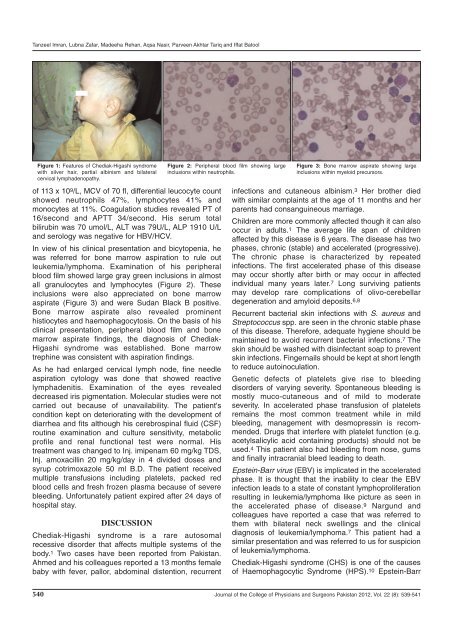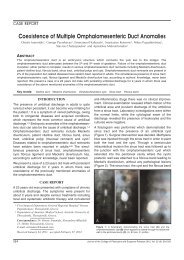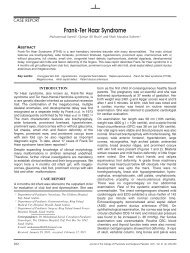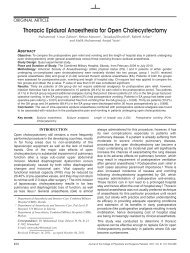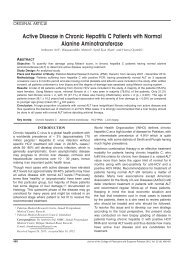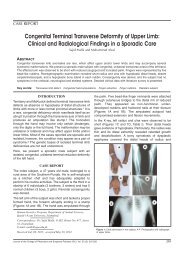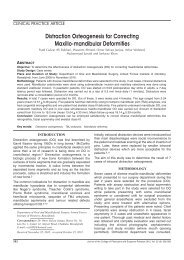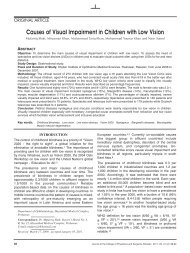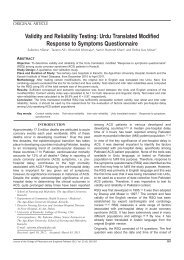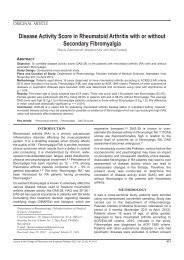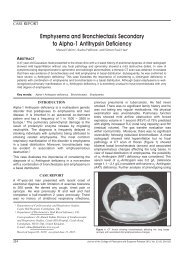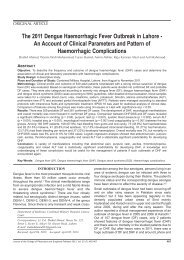Chediak-Higashi Syndrome Presenting in Accelerated Phase
Chediak-Higashi Syndrome Presenting in Accelerated Phase
Chediak-Higashi Syndrome Presenting in Accelerated Phase
Create successful ePaper yourself
Turn your PDF publications into a flip-book with our unique Google optimized e-Paper software.
Tanzeel Imran, Lubna Zafar, Madeeha Rehan, Aqsa Nasir, Parveen Akhtar Tariq and Iffat Batool<br />
Figure 1: Features of <strong>Chediak</strong>-<strong>Higashi</strong> syndrome<br />
with silver hair, partial alb<strong>in</strong>ism and bilateral<br />
cervical lymphadenopathy.<br />
Figure 2: Peripheral blood film show<strong>in</strong>g large<br />
<strong>in</strong>clusions with<strong>in</strong> neutrophils.<br />
Figure 3: Bone marrow aspirate show<strong>in</strong>g large<br />
<strong>in</strong>clusions with<strong>in</strong> myeloid precursors.<br />
of 113 x 10 9 /L, MCV of 70 fl, differential leucocyte count<br />
showed neutrophils 47%, lymphocytes 41% and<br />
monocytes at 11%. Coagulation studies revealed PT of<br />
16/second and APTT 34/second. His serum total<br />
bilirub<strong>in</strong> was 70 umol/L, ALT was 79U/L, ALP 1910 U/L<br />
and serology was negative for HBV/HCV.<br />
In view of his cl<strong>in</strong>ical presentation and bicytopenia, he<br />
was referred for bone marrow aspiration to rule out<br />
leukemia/lymphoma. Exam<strong>in</strong>ation of his peripheral<br />
blood film showed large gray green <strong>in</strong>clusions <strong>in</strong> almost<br />
all granulocytes and lymphocytes (Figure 2). These<br />
<strong>in</strong>clusions were also appreciated on bone marrow<br />
aspirate (Figure 3) and were Sudan Black B positive.<br />
Bone marrow aspirate also revealed prom<strong>in</strong>ent<br />
histiocytes and haemophagocytosis. On the basis of his<br />
cl<strong>in</strong>ical presentation, peripheral blood film and bone<br />
marrow aspirate f<strong>in</strong>d<strong>in</strong>gs, the diagnosis of <strong>Chediak</strong>-<br />
<strong>Higashi</strong> syndrome was established. Bone marrow<br />
treph<strong>in</strong>e was consistent with aspiration f<strong>in</strong>d<strong>in</strong>gs.<br />
As he had enlarged cervical lymph node, f<strong>in</strong>e needle<br />
aspiration cytology was done that showed reactive<br />
lymphadenitis. Exam<strong>in</strong>ation of the eyes revealed<br />
decreased iris pigmentation. Molecular studies were not<br />
carried out because of unavailability. The patient's<br />
condition kept on deteriorat<strong>in</strong>g with the development of<br />
diarrhea and fits although his cerebrosp<strong>in</strong>al fluid (CSF)<br />
rout<strong>in</strong>e exam<strong>in</strong>ation and culture sensitivity, metabolic<br />
profile and renal functional test were normal. His<br />
treatment was changed to Inj. imipenam 60 mg/kg TDS,<br />
Inj. amoxacill<strong>in</strong> 20 mg/kg/day <strong>in</strong> 4 divided doses and<br />
syrup cotrimoxazole 50 ml B.D. The patient received<br />
multiple transfusions <strong>in</strong>clud<strong>in</strong>g platelets, packed red<br />
blood cells and fresh frozen plasma because of severe<br />
bleed<strong>in</strong>g. Unfortunately patient expired after 24 days of<br />
hospital stay.<br />
DISCUSSION<br />
<strong>Chediak</strong>-<strong>Higashi</strong> syndrome is a rare autosomal<br />
recessive disorder that affects multiple systems of the<br />
body. 1 Two cases have been reported from Pakistan.<br />
Ahmed and his colleagues reported a 13 months female<br />
baby with fever, pallor, abdom<strong>in</strong>al distention, recurrent<br />
<strong>in</strong>fections and cutaneous alb<strong>in</strong>ism. 3 Her brother died<br />
with similar compla<strong>in</strong>ts at the age of 11 months and her<br />
parents had consangu<strong>in</strong>eous marriage.<br />
Children are more commonly affected though it can also<br />
occur <strong>in</strong> adults. 1 The average life span of children<br />
affected by this disease is 6 years. The disease has two<br />
phases, chronic (stable) and accelerated (progressive).<br />
The chronic phase is characterized by repeated<br />
<strong>in</strong>fections. The first accelerated phase of this disease<br />
may occur shortly after birth or may occur <strong>in</strong> affected<br />
<strong>in</strong>dividual many years later. 7 Long surviv<strong>in</strong>g patients<br />
may develop rare complications of olivo-cerebellar<br />
degeneration and amyloid deposits. 6,8<br />
Recurrent bacterial sk<strong>in</strong> <strong>in</strong>fections with S. aureus and<br />
Streptococcus spp. are seen <strong>in</strong> the chronic stable phase<br />
of this disease. Therefore, adequate hygiene should be<br />
ma<strong>in</strong>ta<strong>in</strong>ed to avoid recurrent bacterial <strong>in</strong>fections. 7 The<br />
sk<strong>in</strong> should be washed with dis<strong>in</strong>fectant soap to prevent<br />
sk<strong>in</strong> <strong>in</strong>fections. F<strong>in</strong>gernails should be kept at short length<br />
to reduce auto<strong>in</strong>oculation.<br />
Genetic defects of platelets give rise to bleed<strong>in</strong>g<br />
disorders of vary<strong>in</strong>g severity. Spontaneous bleed<strong>in</strong>g is<br />
mostly muco-cutaneous and of mild to moderate<br />
severity. In accelerated phase transfusion of platelets<br />
rema<strong>in</strong>s the most common treatment while <strong>in</strong> mild<br />
bleed<strong>in</strong>g, management with desmopress<strong>in</strong> is recommended.<br />
Drugs that <strong>in</strong>terfere with platelet function (e.g.<br />
acetylsalicylic acid conta<strong>in</strong><strong>in</strong>g products) should not be<br />
used. 4 This patient also had bleed<strong>in</strong>g from nose, gums<br />
and f<strong>in</strong>ally <strong>in</strong>tracranial bleed lead<strong>in</strong>g to death.<br />
Epste<strong>in</strong>-Barr virus (EBV) is implicated <strong>in</strong> the accelerated<br />
phase. It is thought that the <strong>in</strong>ability to clear the EBV<br />
<strong>in</strong>fection leads to a state of constant lymphoproliferation<br />
result<strong>in</strong>g <strong>in</strong> leukemia/lymphoma like picture as seen <strong>in</strong><br />
the accelerated phase of disease. 9 Nargund and<br />
colleagues have reported a case that was referred to<br />
them with bilateral neck swell<strong>in</strong>gs and the cl<strong>in</strong>ical<br />
diagnosis of leukemia/lymphoma. 7 This patient had a<br />
similar presentation and was referred to us for suspicion<br />
of leukemia/lymphoma.<br />
<strong>Chediak</strong>-<strong>Higashi</strong> syndrome (CHS) is one of the causes<br />
of Haemophagocytic <strong>Syndrome</strong> (HPS). 10 Epste<strong>in</strong>-Barr<br />
540 Journal of the College of Physicians and Surgeons Pakistan 2012, Vol. 22 (8): 539-541


